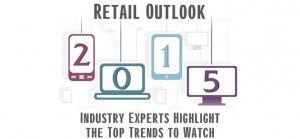By Retail News Insider
 The world of retail is evolving. Though many industry insiders initially brushed these trends off as passing fads, the expansion of mobile apps and m-commerce, the use of tracking beacons for in-store personalization, and the widespread integration of omnichannel solutions amongst both brick-and-mortar and online retailers have all become mainstream in the retail industry in 2014. So what’s on tap for 2015? We asked five industry experts to give us their predictions for the trends that will have the biggest impact on the U.S. retail environment in the coming year.
The world of retail is evolving. Though many industry insiders initially brushed these trends off as passing fads, the expansion of mobile apps and m-commerce, the use of tracking beacons for in-store personalization, and the widespread integration of omnichannel solutions amongst both brick-and-mortar and online retailers have all become mainstream in the retail industry in 2014. So what’s on tap for 2015? We asked five industry experts to give us their predictions for the trends that will have the biggest impact on the U.S. retail environment in the coming year.
Catering to the “Now” Generation

Susan Reda is the Editor at STORESMedia, the publishing group of the National Retail Federation. With over 15 years of experience reporting on the retail industry, Reda guides the editorial direction and writes many of the cover and trend-related stories for STORES Magazine.
Susan Reda, Editor at STORESMedia, thinks the biggest trend in retail in 2015 will be the rise of same-day and next-day delivery. “We live in a society where consumers… want convenience and control, and they want it now,” she says. “While next-day and same-day delivery really challenges retailers—supply chains were never set up for that—we have already seen folks adjusting to [the demand from consumers].”
“A number of upstart companies, like Uber, WeDeliver and Shoprunner, who didn’t have a hand in retail before are now the ones who are going to change how quickly products are getting into the hands of consumers,” continues Reda. “Right now these services are only available in big cities like Chicago and New York, and they’re expensive. But we’re seeing that it’s a luxury consumers are willing to pay for.”
Reda also notes that “as much as [this is] important for online retailers, I think it’s even more important for brick-and-mortar retailers. If they’re in the cities where this is becoming desirable by consumers, this is their opportunity to get that bit of revenge they’ve been looking for.”
“In the past, brick-and-mortar retailers were not set up to do deliveries as fast as online retailers. But now if [a traditional retailer like] Macy’s gets equipped to do this and can connect with a service like Uber and deliver an item in 3 hours, they can satisfy the customer and drive consumer loyalty. When you are on the receiving end of a gift that arrives just in time or an item that saves the day—it makes all the difference [in your perception of that retailer].”
Convenience Stores Become One-Stop Shops—for Brick-and-Mortar and E-commerce

Danny Hongyi Chen has over 10 years of experience in private label development, brand expansion and global sourcing in the U.S., China, Taiwan and Malaysia. He currently leads new business expansion efforts in Asia for Interactions and SAS Retail Services.
Danny Hongyi Chen, Vice President of Asia Retail Services for Interactions, has a strong background in the Asian retail market. When asked what overseas trends he’s currently seeing that he thinks will influence the U.S. retail market in 2015, Chen cites the expanded role of convenience stores as a go-to shopping destination.
“There’s an interesting trend in convenience stores in Taiwan,” Chen says. “Typically, these stores have the advantages [over supermarkets and hypermarkets] of store location and a robust supply chain. The big players in convenience are now offering more things because they are closer to the consumer. They’re starting to change their selection two or three times a day and to offer new things, like fresh. 7-Eleven in Taiwan launched a very strong fresh program. They offer ready-to-eat and ready-to-cook items.”
“This is significant because it used to be rare to see convenience stores have a direct relationship with produce and seafood providers,” explains Chen. “But now they do. And they want to do more. They’re also selling things like concert tickets, train tickets and other services.”
Chen also thinks we’ll see a convergence of e-commerce and convenience stores. “Some e-commerce players in Asia are partnering with convenience stores to do the delivery,” he says. “In the future, they may start taking some of the shelf space in the convenience store to display seasonal items. The shopper could buy an item right there. Essentially, convenience stores will become the showroom or experience center for e-commerce players.”
A Year of Fragmentation—and Catering to the Customer

Virginia Morris heads up Daymon Worldwide’s Center of Excellence on Global Innovation and Strategy. This newly formed group aims to harness the power of Daymon’s windows on the world to develop innovative, actionable solutions for retailers and CPGs.
“2015 is going to be a year of fragmentation,” says Virginia Morris, Vice President of Global Consumer Innovation & Strategy for Daymon Worldwide. “It’s been tricky to keep primary shoppers in our stores. But it’s getting even more challenging. Consumers are getting more choices in destinations and options to fill their shopping needs. Because of this fragmentation, it’s more important than ever to keep shoppers in your ecosystem, whether it’s online, mobile or in-store.”
One thing retailers are going have to deal with in their efforts to keep shoppers coming back is an increasing demand for transparency. “Retail continues to go under the microscope,” says Morris. “There’s increased sharing of information and a quest for understanding from a source perspective and an ingredient perspective. For example, right now a short ingredients label is perceived to be healthier. [In the coming year] additional transparency is going to become a point of entry, not differentiation. It’s about traceability, supply chain and retail innovation. It has pricing implications… and social media amplification implications. [Going forward] retailers have to be having a conversation with consumers, not talking at the consumer.”
Data Security Becomes Top of Mind

Paula Rosenblum is widely recognized as one of the top analysts in the retail industry and was selected as one of the “Top 50 Retail Influencers” by POS software firm Vend. Prior to becoming a retail analyst, Paula spent over 20 years as a retail technology executive and CIO.
Paula Rosenblum, Managing Partner at Retail Systems Research, predicts the biggest trend that will influence the retail market in 2015 is an obsession with data security. “Retailers are going to have to face the fact that keeping customer data safe is now an ongoing job,” says Rosenblum. “It’s going to be a time and money distraction.”
“You can’t have an expectation that you won’t have an intruder. You must have an expectation you will have an intruder,” she warns. “You have to presume that the firewalls will be breached and figure out how to catch the intruders right at the start so they do minimal damage—unlike the recent Home Depot breach where they milked data from self-checkout terminals for five months before they got caught.”
Rosenblum also notes that this focus on security won’t just affect retailers. “You can expect that consumers will go online [in response to data breaches],” she says. “Currently fraud is not very high online in the U.S. But we’ve learned from other countries, once you squeeze fraud out of the stores, it will go online.”
Blurring the Lines Between Virtual and Reality

Abhi Beniwal joined Interactions’ parent company in 2001 and has led several technology initiatives for supply chain, business intelligence, consumer and mobile solutions. In 2011 he was named one of the Top 25 Information Managers by Information Management.
“In the next year, we’re going to see the lines between online mobile and the real world begin to blur,” predicts Abhi Beniwal, Senior Vice President of IT for Interactions. “There are new technologies coming out that will change the experience of online and how you look at, touch and feel a product. The reason people go into the store today is to touch, feel and see. That line of differentiation will start getting blurry.”
“These technologies aren’t just augmented reality,” continues Beniwal. “They’re more than that. For example, Google just invested in Magic Leap, a technology that’s not augmented reality or virtual reality but something that’s actually making it hard to see where the physical world ends and the online world begins.”
According to its CEO and founder Rony Abovitz, Magic Leap is a mobile wearable computing system that works with the human visual perception system to create realistic 3D images that will revolutionize the way people communicate, purchase products, learn, play and share.
“Technologies like this are not only going to be online, but also in-stores,” says Beniwal. “It will be interesting to see which retailers will make the first breakthroughs with this technology because there are a few in the forefront. The rest will be watching and following.”
Though these trends seem quite diverse, one thing all of our experts agree on is that consumers are the driving force behind these—and the majority of other—retail changes. As Morris puts it, “These are consumer-led trends. And retailers are having to respond. Retail is shifting to meet the ever-changing needs of the consumer.”

